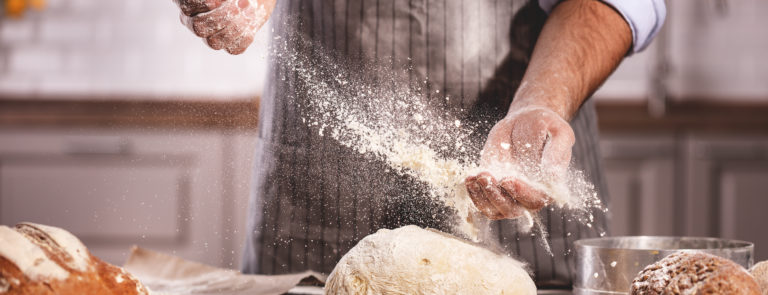15% off £30
How to choose the best bread flour

Any bread aficionado will tell you selecting the best bread flour is one of the most important decisions you’ll make when learning how to bake bread. But which one do you choose?
If you’re looking to put on your apron and bake your own loaf, prepare to be baffled by the range of flour now on supermarket shelves. There are certainly plenty of types of flour you can experiment with. All-purpose, rye, wholemeal, spelt – each will give your bread a unique taste, appearance and texture.
But before we talk about the varieties, let’s start with some baking science. Why is flour so important to the bread-making process?
What is bread flour?
Bread flour is a type of white flour that is milled from hard red spring wheat grains. It has higher protein content than other types of flour, around 13 to 16.5% by weight.1 This is important when it comes to baking bread because more protein means more gluten, and more gluten means more elasticity in the dough which will result in higher rising loaves of bread.2
Why do you need flour in bread?
Much for the same as the above reason. Out of all the components of flour, protein is the most important to a baker. The two different types of protein in flour are glutenin and gliadin.3 When they mix with water, together they create gluten, and this gives bread its structure. Glutenin creates elasticity (chewiness), and gliaden extensibility (the height of the rise).4
Types of bread flour
These are the most popular wheat-based flours used to make bread5:
-
All-purpose flour
All-purpose flour has a gluten content between 9-11%. Usually, it’s made of a combination of hard and soft wheat, and comes in two types, bleached and unbleached.
Unbleached flour is naturally aged to oxidise the proteins and bleach out the natural yellow pigment present in freshly milled flour.
Both flours are equally useful in the bread making process.
-
Bread flour
As the name suggests, this type of flour is generally used for making bread.
Bread flour has a higher percentage of gluten, usually between 11-14%, which makes the dough more elasticated and easier to work with when creating light-textured breads.
Bread flour can be substituted with all-purpose flour, but you must keep in mind that bread flour, since it has a higher gluten content, requires more liquid. So, you’ll need to add more or less water, depending on which flour you choose.
-
Whole wheat flour
Whole wheat flour has the highest percentage of gluten, sometimes up to 16%. It’s made from whole wheat berry, including oil-rich bran and germ.
If it says its 100% whole wheat flour, then that means that nothing was added or taken away.
-
White whole wheat flour
White whole wheat flour is made from a different type of white spring wheat that is sweeter and lighter in colour.
It has a gluten percentage of around 12% making this type of flour a good substitute to all-purpose flour with no loss of light texture. It is as nutritious as whole wheat flour but with a milder taste.
How to choose the best flour to make bread?
Different types of flour contain varying qualities and concentrations of gluten protein. This will have a big influence over how the flour performs during your bake. Specifically, how supple your dough is and how much it will rise.6
But is there really any meaningful distinction between a strong white bread flour and a plain all-purpose baking flour? There’s probably a bigger difference than you might imagine. And this is mainly down to how much protein they contain.
Flours with different protein levels are better for different types of baking. Whereas an all-purpose flour has a protein content of around 11%, a harder bread flour or whole wheat flour contains 12-15% protein.7 Lower densities of protein create a softer flour and a lighter texture.
So, as a general rule, the higher the protein content, the stronger the flour and the crustier the bread.
Your choice of flour will have a big impact on the texture and style of your bread. So, if you’re wondering how to make sourdough bread, you’ll probably find most recipes recommend a strong white bread flour over an all-purpose flour. This is because the higher protein content of bread flour will help you create the high rise and rustic crust of an artisan style loaf.
If, however, you’re looking to bake a super soft brioche, you’ll need to use a bread flour in the lower protein range.8
Best flour for bread making
-
All-purpose flour
It has a gluten content between 9-11% and is probably the most widely used in bread.
-
Bread flour
A higher gluten content (11-14%) creates a more elastic dough. This bakes breads with a higher rise and a lighter texture.
-
Whole wheat flour
This flour has the highest gluten percentage (up to 16%.) But rather than a fluffy texture, breads made with whole wheat are typically heavy and dense in texture.
-
White whole wheat flour
It has a milder taste than whole wheat flour and with a gluten percentage more around 12%, it creates a lighter texture bread. It’s a good alternative to all-purpose flour.
Gluten free bread flour
If you’re intolerant to gluten, learning how to bake bread is a great way to be sure only the right ingredients for your sensitivity are used to make your loaf. Here are some lower gluten flour options:
-
Spelt flour
What is spelt flour? Spelt is a grain. It’s a variety of wheat, so it contains gluten. However, with fewer fructans (which can be hard to digest) it can be a good alternative to conventional wheat flours if you need to reduce (but not total eliminate) gluten.
-
Rye flour
Rye flour has a rich, slightly sweet flavour. Similar to spelt flour, it contains a lower level of gluten, making it a suitable substitute if you want to reduce your gluten intake due to a sensitivity.
Non wheat bread flour
To avoid gluten altogether, you could look for gluten-free bread recipes using the following instead of refined wheat flours.
- Buckwheat flour
- Millet
- Coconut flour
- Almond flour
Note: The above don’t rise so you’ll need to use a rising agent in order to make bread.
What can I make with bread flour?
You can make various types of breads, pizza dough, pretzels, hot cross buns and various other bread based goodies.
Summary: Your choice of flour is important
Flour is the most important ingredient in bread as it determines the texture and rise of your loaf. Wheat flours are usually the first choice of most bakers.
This is due to the lightness and high rise created by higher levels of gluten content. However, if you’re intolerant of wheat or looking for gluten-free bread options, there are a wide range of low gluten and gluten-free flour options available.
Last updated: 15 April 2021
- https://www.epicurious.com/expert-advice/bread-ingredients-guide-to-flours-for-homemade-dough-article
- https://www.masterclass.com/articles/how-to-make-bread-flour-substitute/
- http://atreatsaffair.com/bread-baking-101-flour/
- https://www.epicurious.com/expert-advice/bread-ingredients-guide-to-flours-for-homemade-dough-article
- https://www.finecooking.com/article/choosing-flour-for-baking
- https://www.finecooking.com/article/choosing-flour-for-baking
- https://www.epicurious.com/expert-advice/bread-ingredients-guide-to-flours-for-homemade-dough-article
- https://www.epicurious.com/expert-advice/bread-ingredients-guide-to-flours-for-homemade-dough-article














